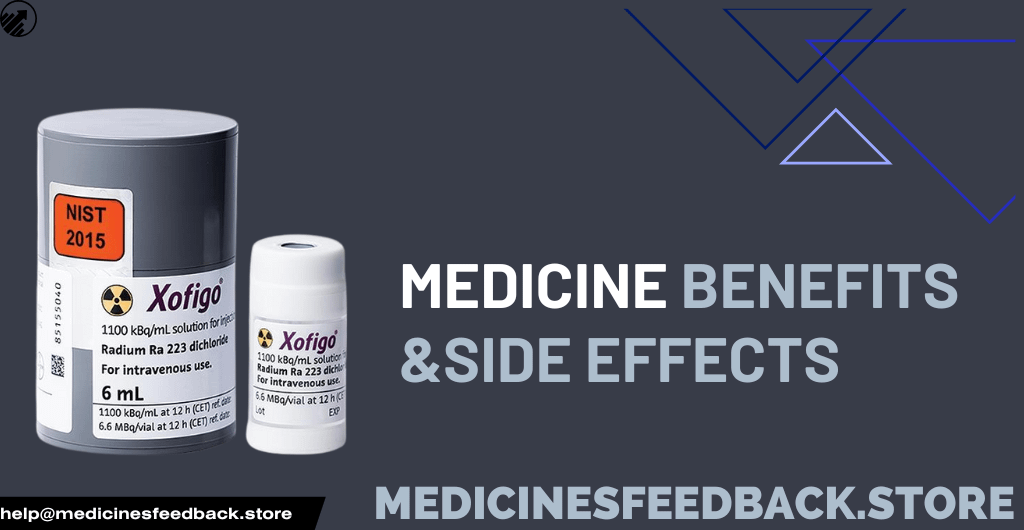- Briefly introduce Xofigo as a treatment for advanced prostate cancer.
- Mention its purpose in targeting bone metastases and enhancing quality of life.
- Set the tone for an informative article on benefits, side effects, and essential considerations.
What is Xofigo?
- Explain Xofigo’s purpose as a radiopharmaceutical used in treating metastatic prostate cancer that has spread to bones.
- Mention its active ingredient, radium-223, which mimics calcium to target bone metastases.
- Note that it is generally prescribed for men whose cancer has stopped responding to other treatments.

How Does Xofigo Work?
- Describe how radium-223 selectively targets and binds to areas with increased bone turnover.
- Explain that Xofigo emits radiation directly to the tumor sites in the bones, reducing the risk to healthy tissues.
- Highlight how this mechanism minimizes pain from bone metastases and may help slow cancer progression.
Key Benefits
- Pain Relief: Outline how Xofigo can alleviate bone pain often caused by metastatic cancer, leading to improved comfort.
- Increased Survival Time: Mention studies suggesting that Xofigo may extend overall survival in men with advanced prostate cancer.
- Low Risk to Healthy Tissue: Explain the targeted nature of Xofigo’s radiation, which helps limit exposure to healthy cells and tissues.
- Enhanced Quality of Life: Emphasize how pain relief and decreased tumor progression in bones can improve daily activities and quality of life.
- Easy Administration: Describe the administration process, typically involving a series of injections with minimal recovery time required.
Potential Side Effects of Xofigo
- Blood-related Side Effects:
- Discuss risks of anemia, low white blood cell counts, and thrombocytopenia, which can affect immunity and energy levels.
- Digestive Issues:
- Cover common side effects like nausea, vomiting, and diarrhea, with tips for managing these.
- Fatigue:
- Address potential fatigue, a common effect of many cancer treatments, and strategies to help cope.
- Bone Pain:
- Explain that while Xofigo can reduce cancer-related pain, some patients may experience bone pain post-treatment.
- Swelling:
- Mention possible swelling in the limbs due to lymphatic effects, advising patients to consult with their doctors if it occurs.
Who is a Suitable Candidate for Xofigo?
- Outline criteria for Xofigo, including advanced prostate cancer with bone metastasis and hormone-resistant disease.
- Note the importance of consulting with an oncologist to assess suitability based on individual health needs.
Xofigo Treatment Process
- Administration Schedule:
- Describe the usual injection cycle and duration, typically every four weeks over six doses.
- Pre-Treatment Preparation:
- Discuss any dietary or medication adjustments recommended before beginning Xofigo.
- During and After Treatment:
- Describe the follow-up process, monitoring for side effects, and any lifestyle changes that may be recommended.
Precautions and Warnings
- Mention the importance of regular blood tests to monitor blood cell counts.
- Advise patients to report any unusual side effects, like severe fatigue, bleeding, or swelling.
- Note that Xofigo is contraindicated in women and children and should be handled carefully.
Frequently Asked Questions (FAQs)
- How soon will I see results ?
- Can Xofigo be used alongside other cancer treatments?
- How does compare to other prostate cancer treatments?
- What should I do if I miss a scheduled injection?
- What lifestyle changes can help improve treatment outcomes?
Conclusion
- Summarize Xofigo’s benefits in managing pain and improving quality of life for patients with advanced prostate cancer.
- Encourage readers to consult with their healthcare providers to discuss whether Xofigo is suitable for them.
he price of Xofigo (radium-223 dichloride) can vary significantly depending on the country and healthcare system. In the United States, a single 1-unit dose of Xofigo is priced at approximately $30,767, although patient assistance programs are available to help reduce this cost for those who qualify. In other countries, prices may differ based on local healthcare subsidies, generic availability, and insurance coverages. For instance, in countries where healthcare systems subsidize oncology drugs, prices may be lower for patients, but exact figures depend on individual cases and locations.




